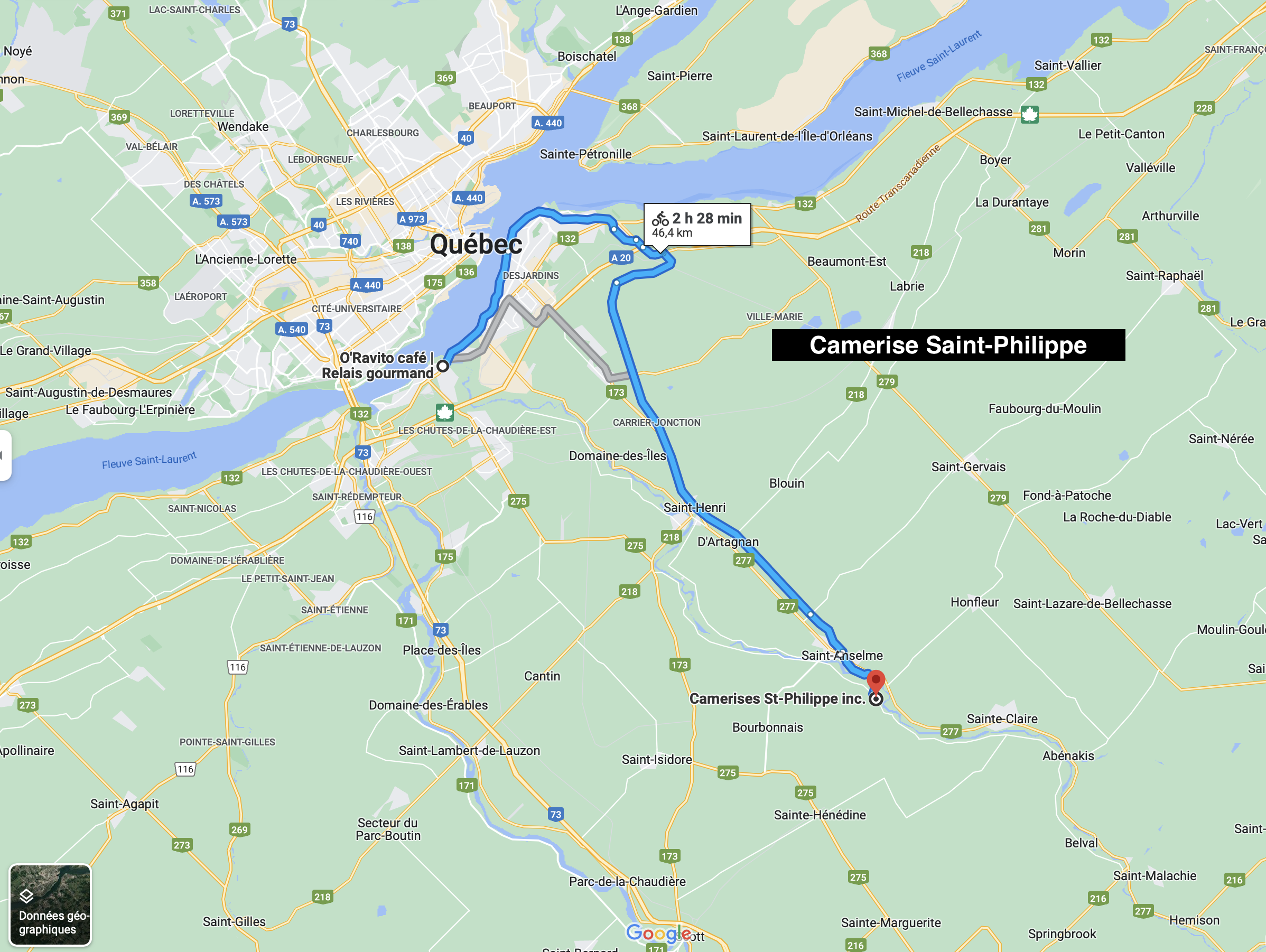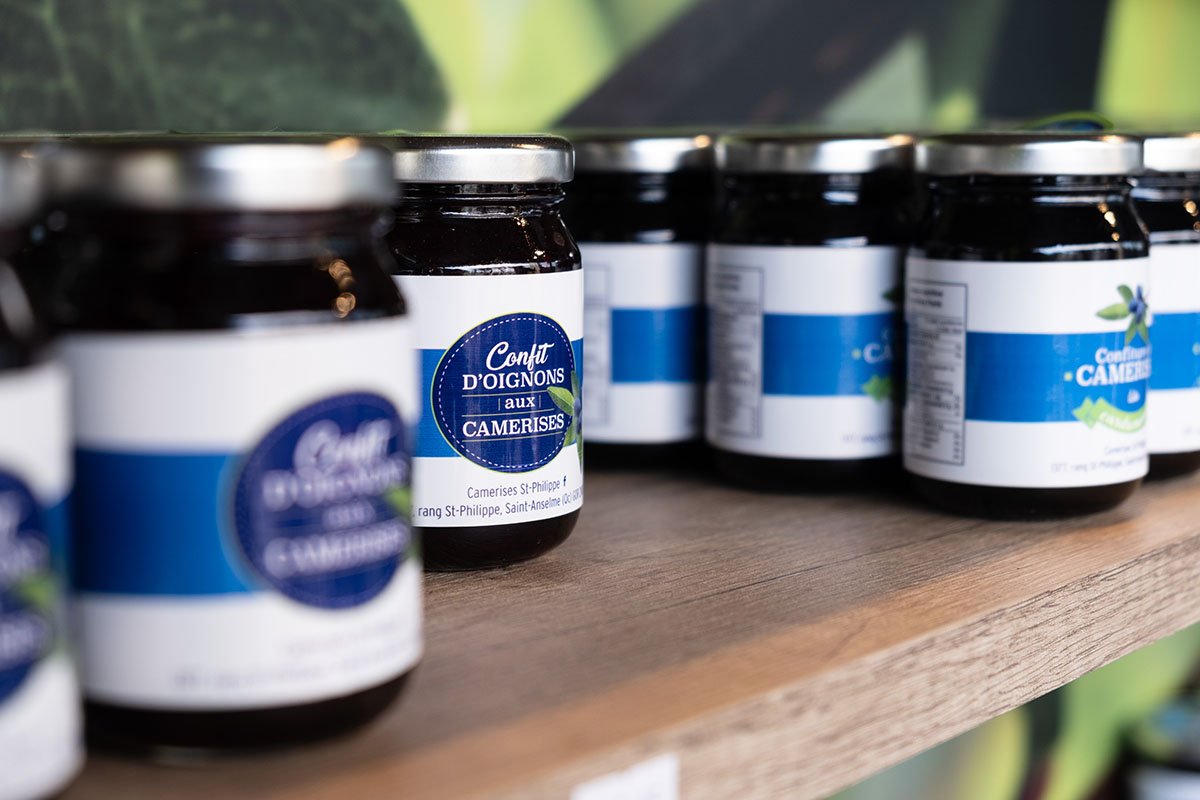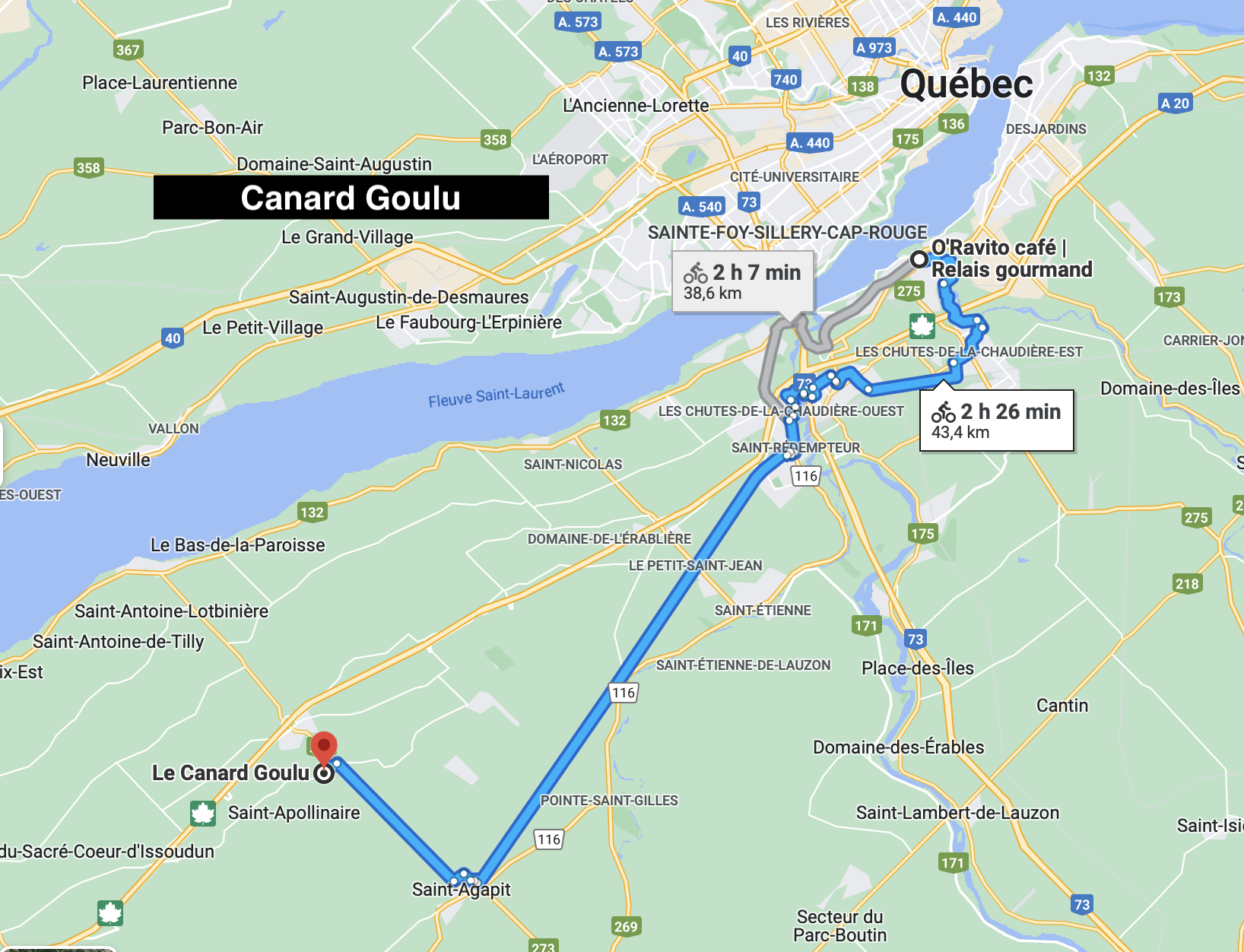New gourmet bike tours by O'Ravito
The best café in Lévis now offers gourmet bike tours to four favorite producers in the region. I took the tour with owner Ann-Rika Martin.
I met Ann-Rika Martin, owner of the O'Ravito Café Relais in Lévis, during the filming of first episode from the webseries Le bon monde de la Route verte.
The sympathetic winner of the show Les Chefs, at Radio-Canada, prepares everything that is offered at his café: from mustard to bread to lemonade. For its specialized products, it is supplied by agri-food producers in the region. It is the latter that it wishes to discover this summer thanks to brand new one-day cycling tours.
From July to September, four producers will open their doors a few times to Ann-Rika's guests, who will cycle around 30 to 90 km depending on the destination. Among other things on the menu: gin, cider, apples, blueberries, haskap, duck. The destinations have been placed on the calendar according to the best times for U-pick.
Each time, a cycling supervisor will guide the small group. A vehicle will also accompany them – sometimes driven by Ann-Rika herself – to transport personal effects, the lunch provided and bring back purchases.
The dozen gourmet tours offered to the public are detailed here. Private reservations can also be made by contacting Ann-Rika.
To help you make your choice better, I myself set off with the chef in the four tours offered:
Ann-Rika and I arrive by bike at Camerises Saint-Philippe.
APPALACHIAN DISTILLERY
Like all the itineraries offered, the one to the Appalachian Distillery leaves from Café O'Ravito, located in Saint-Romuald. The whole route follows the course of Les Anses, one of the seven bike paths in the Chaudière-Appalaches region.
Along the way, you will also stop at AC Davie shipyard museum as well as birthplace of the poet and playwright Louis Fréchette. Explanations are given by guides at these two places.
The Anses route crosses all of Lévis following the river and offers beautiful views of Québec.
The landscape becomes forest as you approach the distillery.
At the Distillerie des Appalaches, Fabiola, the sales, catering and events representative, takes us on a tour. Everything is shiny and new in the company founded four years ago. The shop where the many products are presented was completed in the last year.
The gins carry the appellation Kepler (named after the German astronomer) and the fabulous labels, created by the artist Pier-Olivier Caouette, all have space themes. The gin Alphonse, meanwhile, is non-alcoholic and a staple in Ann-Rika's personal wardrobe. There is also a succulent amaretto Black Forest (which really tastes like the cake of the same name!) as well as whiskeys made from Scotch Scotch.
The room next to the shop is used for distillation. Fabiola explains to us that the infusions are made from fresh fruit, balsam fir and, of course, juniper for the gin. Bottling and labeling is done on site, automatically. “But the plastic that covers the cap is still a manual operation for now! says Jorge, a smiling Chilean who has been living in Quebec for seven years. Her eyes light up with pride when I tell her about my bike ride through her home country.
Fabiola's favorite product is gin Stellar, with a fruity taste produced from black raspberry, blood orange and lemon. But the most popular gins at the distillery are the Seaside (strawberry, rhubarb, cucumber, wakame seaweed) as well as Celestial (white peach, pear and holy basil). I raise my eyebrow at the last ingredient. “Yes, yes, confirms Mathieu, with a smirk, a priest comes to bless our batches once a week ! »
Jorge, surrounded by bottles ready to be filled and labeled.
Mathieu, Jorge, Fabiola and Luc.
LE SOMNAMBLE CIDER HOUSE
A stone's throw from the Etchemin River and just off the Bellechasse cycle route is the Somnambule cider house.
The place was already an orchard and vineyard for more than 30 years before being bought by Émile Robert and Ève Larouche Laliberté. “We were lucky with the interest rates! laughs Émile, who is just 33 years old and has been the owner for seven years.
Ann-Rika is full of praise for the producers. “They are really impressive,” she tells me.
In just seven years, they have created products that really stand out and can be found in the greatest gourmet restaurants in Quebec.
-Ann-Rika Martin
If the orchard has kept a certain agritourism side and it is always possible in season to pick your own apples and blueberries there, Émile and Ève were among the first in the province to be part of a new wave cider house. “We were inspired by what was being done for natural wines and microbreweries,” Émile confides to me. Each of their products has a strong visual signature, which starts with a drawing or a painting.
Their range of some 25 products includes dry, semi-dry or more fruity ciders. Many also bear the term “nature”. "We could have made them as they were 2000 years ago," boasts Émile. We use indigenous yeasts and 100% of the apples used come from here. Nothing else is added. Either way, it's the natural fermentation, not the addition of carbon dioxide, that creates the fizzy bubbles. Each cider requires between six and 18 months to come to life.
Émile Robert is the owner, with his spouse Ève Larouche Laliberté, of Cidrerie Le Somnambule.
Some of the approximately 25 products created on the farm
Émile Robert shares with me the chances that led him to create ciders. Between CEGEP and university, he worked in the grape harvest near Bordeaux, France. After a master's degree in chemistry, he pursued a doctorate where he was offered the opportunity to study the aromas of cider in Quebec. At the same time that he worries about the few professional outlets that will conclude his years of research, he realizes that there are a number of business opportunities in the field. It ditches search for a more hands-on experience. His spouse Eve, then a sociologist, embarked with him on the purchase of thirty hectares of apples, vines and blueberries. "It's the glue of the company!" Émile says passionately of his business and life partner.
Besides on site at the Saint-Henri cider house, the products can be found in a hundred points of sale in Quebec in addition to the SAQ network. One of their flagship products is the Celestial, flavored with blueberries.
Émile looks at his watch and apologizes for having to leave us quickly to pick up his daughter. " How old is she ? I ask him. “Almost two years old, she was born in September… at the same time as the apples! »
CAMERISES SAINT-PHILIPPE
A must stop is Bellechasse cyclomur, on both sides of the eponymous 74 km long cycle route. Built a decade ago, the cyclomur consists of two facades decorated with bicycles dating back to the 1950s and 1960s, donated by citizens of neighboring villages.
Almost immediately after, in Saint-Anselme, Ann-Rika and I turn towards the Camerises Saint-Philippe Farm, the name of the rank on which it is located. There is Denis Carrier, owner with his spouse Nancy Jacques of 200 acres, including eleven where haskaps are grown.
The Bellechasse cyclomur
And the other side of the Bellechasse cyclomur
Ann-Rika on the silky Bellechasse cycle route
Denis invites us to take a seat around a manicured circle of stones bordering his long rows of fruit. His father's farm was a dairy farm for a very long time. “I took over from my father at 22, Denis tells me, and I pumped milk for 35! But the farmer wanted a greater relationship with his customers, to meet those who consume what he grew. With milk, and even cereals, it was impossible.
He first had the blueberry in mind. “A blueberry is wild, it cannot be cultivated! his mother had replied. “You should have seen my face when I saw my first big fields of blueberries! remembers Dennis. I immediately called my mother! But the market was, he said, already saturated. “Around 2012, there were some in all ranks! »
He turns to haskap, a variety of domestic honeysuckle, the same color as blueberries but longer in shape. Quebec varieties were little appreciated before the crossings made by the University of Saskatchewan with other fruits from Russia and northern Japan. Only since 2007 the fruit began to be grown with us.
Denis put his first plans in the ground in 2014 and took care of it for three years before seeing the first fruits appear. " And the little criss cedar waxwings have eaten them all! he exclaims. The farmer explains to me that birds that ingest too much fruit get poisoned and “act like hot guys”.
I was doing lengths on four-wheelers between the rows to try to scare the waxwings and save my crop. There is one who followed me and looked at me calmly. He drooled the sacrament!
Since then, nets have been installed over the plans. And the unfortunate anecdote gave its name to the delicious haskap liqueur produced on site: le Voleur!
A handful of dried haskaps
Denis Carrier and his bottle named in honor of the berry's worst enemy, the cedar waxwing or American waxwing
The Bellechasse cycle route passes directly by the farm.
In its first years of production, Denis Carrier also had to work to publicize the new fruit. “Haskap can only be kept for a day or two, you have to freeze it right away. So I went around the restaurants of Quebec with my cooler and gave them a taste on the spot. »
Ann-Rika is one of those who adopted the berry. “As a starter with duck, it's exquisite! Also in chutney or jam. And since the fruit is quite acidic, it never gets too sweet. »
One of the farm's products: haskap vinaigrette
And candied onions with haskaps.
On site at the farm, it is possible to pick your own, around the end of August. The shop also contains several products, from vinaigrette to confit, including beer and wine. "Alcohol is Nancy's fault!" said Denis, throwing the "blame" on his wife. The first wines, made with “little yeast kits and grandmother's recipes”, turned out to be better than expected. The couple decides to persevere in this way. With the still fermentation residues, gin and liquor are then made.
Their gin is called Entry 38 in honor of a major search of the barn behind the farm during the Prohibition era. "Nine men were arrested," says the talkative Denis. Guys from New York, New Brunswick, Maine and here. His father was then 16 years old and, according to his memories, he found it "weird that the guys only spoke English"! The bottle label Entry 38 is decorated with period newspaper articles. “They owed $100 in tax (in 000), says Denis, it was really a big operation. »
The farm having the title of artisanal producers, its alcohol products are only sold on site. All the more reason to visit them. I myself left with a bottle of the famous Voleur. And paid all my taxes.
Terego
Some VR members of Terego.ca were stationed on the land of Denis and Nancy. This organization offers no less than 1400 RV parking lots across Canada, at artisans, microbreweries, vineyards, orchards, maple groves and farms of all kinds. A great alternative to large campsites.
The fruits are protected from waxwing birds by nets.
GREEDY DUCK
The road to the farm Greedy Duck first takes us across the impressive Chaudière River footbridge. At 23 m above the waves, you can't help but stop to contemplate the powerful falls. The majority of the path then passes through the linear park of the MRC de Lotbinière. In Saint-Agapit, the shoulder of Route 273 takes cyclists to the producer.
If you choose this visit, you will find the owner Sébastien Lesage there, who explains that in 1997 he swapped the lawyer's gown for the checkered shirt. Perhaps in memory of the ducks he raised as a child in the pond at his parents'.
The entrepreneur now owns three farms, an artisanal slaughterhouse under permanent inspection, a food processing plant and two points of sale in addition to the shop at the Saint-Apollinaire farm.
The route to the Canard Goulu passes through the impressive Chaudière River footbridge.
The delicious homemade lunch prepared by Ann-Rika
The slaughterhouse and the processing plant are located directly on the farm and the majority of the products are thus prepared on site.
The farm is not lacking in different products. Especially duck, of course. Cooked products, preserves and fresh meat. Rillettes, broth, sausages, foie gras and pâté, terrine, duck breast. There are even duck steaks, duck legs and BBQ duck wings.
Among the by-products, I found a recipe book and some handmade soaps.
Recipe book (credit @lecanardgoulu)
Handmade soap (credit @lecanardgoulu)
Duck foie gras sauce, perfect for poutine! (credit @lecanardgoulu)









































It runs a lot better once properly equipped!